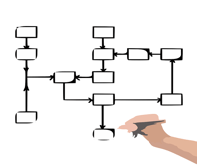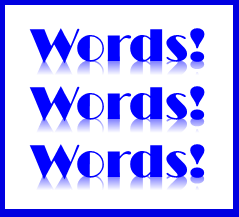 Writer’s block and looming deadlines can make work challenging for any writer regardless of what they’re writing. But disorganization and randomness can make completing writing tasks and projects seem almost impossible at times.
Writer’s block and looming deadlines can make work challenging for any writer regardless of what they’re writing. But disorganization and randomness can make completing writing tasks and projects seem almost impossible at times.
If you want to get the most out of your writing workflow, it’s important to have a writing workflow first, then discover how you can optimize it. Below are best practices for designing your very own writing workflow, and how you can maximize it.
Nail Down Your Perfect Routine
Here’s Merriam-Webster’s definition for “workflow”: “the sequence of steps involved in moving from the beginning to the end of a working process.” So, if you want to maximize your writing workflow, it’s probably best to start with the beginning steps you take when you sit down to write.
When maximizing your writing workflow, it’s essential to first understand when you are more prone to complete your best work. You should know when the optimal hours in the day are for you to write, and then you should exploit them! Are you a night owl or an early bird? Don’t waste time forcing yourself to write something at three in the afternoon if you’re dragging or unmotivated. Read Here's the Best Time for You to Write, According to Science to learn more about when the best time is for you to write and why you should strive to write when you are most alert.
After you determine when you’re most likely to be alert and motivated for writing, develop a routine centered around that time frame on the days you need to complete writing work. Humans are habitual creatures who are naturally routine-oriented. And once you build a routine and follow it for a month or so, you’ll be ready to sit down and write every single time. You’ll be less distracted and will easily be able to complete the act of writing, even if you’re a bit lethargic on a certain day. Think about it. There’s a reason why some of the greatest writers in history have always followed rituals and routines. Read Famous Authors with Unique Writing Rituals and Why You Need One to learn more about the importance of keeping a writing ritual and routine.
Use a Calendar to Plot Out Each Writing Step for Every Writing Project
This may seem obvious at first, but you’d be surprised how many writers don’t put what they need to get done on a calendar. They just think they’ll work on things when they “get some time.” But as a writer, it’s important to always set deadlines for everything you write, even if you need to set the deadlines yourself and you don’t have an editor telling you when something needs to be published. Otherwise, you’ll always find yourself running out of time and scrambling last-minute to turn in something that doesn’t even remotely resemble what you’re capable of if you were to give yourself enough time. Furthermore, jotting down a due date for a writing project on your calendar will never be enough if you want to maximize your overall writing workflow. You should also include mini-tasks and the individual steps you’ll need to execute to maximize your writing workflow on the calendar.
As soon as you get a writing project, take a moment to figure out how long the entire project will take, from beginning to end, and then break it up into steps and stages on your calendar. For instance, writing an e-book for your employer that’s 20 pages will probably take about a month, depending on your other workload and how much research or preliminary work it requires. One week, you’ll probably want to focus on conducting research and outlining your e-book. The following week you might want to write the introduction chapter and the concluding chapter. Then you’ll want to write the main chapters. And then during the final weeks, you’ll want to focus on sections that you’ll need to rewrite, rearrange, and edit. If you must rely on others to secure information for your e-book and to edit your e-book, you may want to allot an additional week or so to give everyone working on the project enough time to contribute their portion of the work.
Each writing project will require its own unique steps and stages. A detailed 100-page white paper covering industry research will take much longer than a blog post, for instance. But each project should still have each of its steps plotted out on your calendar, especially if you’re simultaneously juggling multiple writing projects. When necessary, hire an editor or project management professional to help you keep your writing calendar intact. And if you aren’t sure what steps a writing project will entail, reach out to your network and do a bit of digging so you can pace yourself.
Be Sure to Write in Distinct Stages
Start by plotting your writing workflow tasks on the calendar. It’s important to not let writing tasks overlap, so that you stay on track. For instance, don’t start editing the first half of your e-book if you haven’t even written the final portion of your outline, unless that’s what you’ve already plotted out. This may seem a little “type-A” at first, but think about it: If you sit down to outline a book, but all of a sudden start writing the third and fourth chapters, are you considering the entire flow of the book? If not, then you’ll probably end up spending a lot longer editing and rewriting the entire final draft of the book. So, while it’s of course possible to write different sections of a piece of writing in any order you desire, it won’t end up saving you any time or maximizing your overall writing workflow. But writing in distinct stages and steps will.
The point here is to simply be aware of what it is you’re trying to accomplish during any writing stage so that you don’t get preoccupied or distracted, and so you stay focused throughout the entire time you’re working on your writing project. Be deliberate when you sit down to work on a writing project. Know when you’re conducting research, when you’re outlining something, when you’re writing or rewriting something, etc. Try hard to not overlap your writing stages and steps.
Save Your Resources and Research in a Central Location
To save time and maximize your writing workflow, save all your research and documents in one place that’s easy to access from anywhere. You can use cloud-based services like Microsoft Office 365 or Google Drive that make everything easy to access via a web browser. You can also use cloud-based services like Evernote and Pocket to save links and notes regarding your research. Doing this is especially critical if you have a specialty or niche that you write for on a continuing basis. Think of all the time you’ll save when you don’t have to constantly search for resources and material you’ve covered before.
You can also use cloud-based project management tools like Trello and Asana to keep track of your writing workflow tasks and schedules. Learn more about how you can use technology for free to improve your writing workflow. Download our complimentary e-book: Free Ways to Use Technology to Become a Better Writer.
Take Breaks
Last but certainly not least, remember to take breaks if you really want to maximize your writing workflow. At first this may seem counterintuitive, but it’s really not. If you schedule seven or eight hours of continuous writing on your calendar for six days a week, you’re going to burn out, lose your motivation to write, and be more prone to making mistakes, which will take longer to edit. You need to step away and rest so you can come back to your writing rejuvenated and ready to work again when you’re most likely to get your best writing work done. This is why writing in stages helps too. It will allow you to take your time and stay focused on one (and only one) writing task every single time you sit down to write.
Is there anything you like to do to maximize your workflow? Share with us in the comments below.




